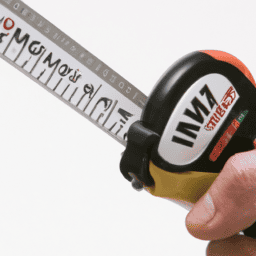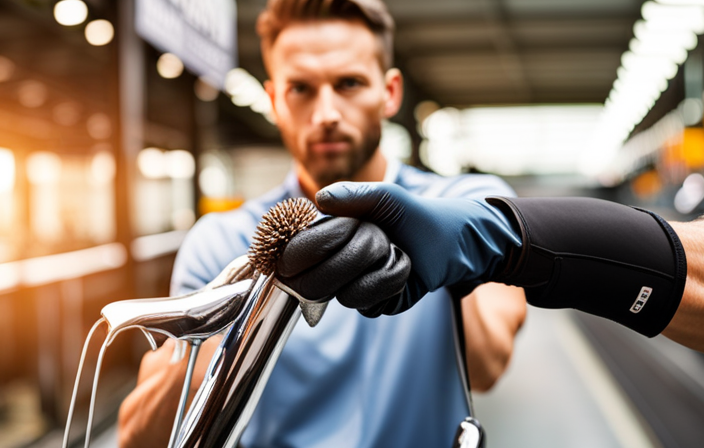Replacing an inner tube on a bicycle is essential for keeping the bike functioning properly, just like replacing a vital organ in the body. In this tutorial, I will guide you through the step-by-step process of changing an inner tube on your bicycle.
With the right tools and materials, you’ll be able to confidently tackle this task and get back on the road in no time.
So let’s dive in and learn how to keep your bike running smoothly by changing its inner tube.
Key Takeaways
- Responsible disposal of old inner tubes contributes to a cleaner environment.
- Practicing inner tube replacement enhances skills and effectiveness.
- Inner tube replacement helps troubleshoot common issues.
- Following the steps for inner tube replacement improves technique and efficiency.
Gather the necessary tools and materials
Gather all the tools and materials you’ll need to change the inner tube on your bicycle. It’s important to have everything prepared before you begin the process.
Common mistakes to avoid when changing a bicycle inner tube include using the wrong size tube, not properly inflating the tube before installing it, and not checking the inside of the tire for debris that could cause another puncture.
To ensure a successful tube replacement, make sure you have a tire lever, a new inner tube that matches the size of your tire, a pump or air compressor, and a patch kit in case of future punctures. Additionally, consider these tips for choosing the right inner tube for your bicycle: check the tire size, consider the type of riding you do, and determine the valve type.
Now that you have all the necessary tools and materials, let’s move on to removing the wheel from the bicycle.
Remove the wheel from the bicycle
To start, you’ll need to detach the wheel from your bike. This is an important step to ensure that you can safely remove the inner tube and replace it. Here’s how you can remove the wheel from your bicycle:
-
Shift the gears: Before removing the wheel, shift the chain onto the smallest chainring and the smallest rear cog. This will make it easier to remove the wheel.
-
Loosen the quick-release lever: Locate the quick-release lever on the axle of the wheel. Loosen it by turning it counterclockwise until it is loose enough to release the wheel.
-
Remove the wheel: Once the quick-release lever is loose, pull the wheel out of the bike frame. Be careful not to damage any brake cables or derailleur.
After safely removing the wheel, you can proceed to deflate the tire and remove the old inner tube. This will allow you to clean the wheel before reinstalling it.
Deflate the tire and remove the old inner tube
Start by releasing the air from the tire and then removing the old tube. To begin, locate the valve on the inner tube and use a valve cap remover or a small tool to depress the valve and release the air. Ensure that all the air is expelled from the tire by squeezing it gently.
Next, inspect the valve for any damage or wear. A damaged valve must be replaced to prevent future problems. Once the tire is completely deflated, it is time to remove the old inner tube. Start by carefully prying one side of the tire bead away from the rim using a tire lever. Once the tire bead is detached, carefully pull out the old inner tube. While doing this, take a moment to check the rim tape for any signs of wear or damage.
Now, let’s move on to inspect the tire for any damage or debris.
Inspect the tire for any damage or debris
Check the tire for any signs of damage or debris before proceeding. Inspecting the tire for damage is crucial to ensure a safe and smooth ride. Carefully run your fingers along the entire surface of the tire, feeling for any cuts, punctures, or bulges. If you notice any damage, it’s important to replace the tire before installing the new inner tube.
Additionally, visually inspect the tire for any foreign objects such as glass, nails, or thorns that may have become embedded. Remove any debris using a pair of tweezers or a small pick tool, being careful not to damage the tire further.
Once you have thoroughly inspected the tire and removed any debris, you can proceed to installing the new inner tube, ensuring a secure and reliable fit for your bicycle ride.
Install the new inner tube
After inspecting the tire for any damage or debris, go ahead and install the new inner tube. Installing the inner tube correctly is crucial for a smooth and safe ride. Here are some installing techniques to follow:
- Begin by placing the deflated tube inside the tire, making sure it is evenly distributed.
- Starting at the valve stem, carefully tuck the tube into the tire, working your way around the wheel.
- Avoid pinching the tube between the tire and the rim by using your hands to guide it in.
- Once the tube is fully inside the tire, use your fingers to push the tire bead back onto the rim.
Table:
| Installing Techniques |
|---|
| 1. Place deflated tube inside the tire |
| 2. Tuck the tube into the tire, starting at the valve stem |
| 3. Avoid pinching the tube by guiding it with your hands |
| 4. Push the tire bead back onto the rim with your fingers |
Now, you can move on to the next step of inflating the tire to the recommended pressure.
Inflate the tire to the recommended pressure
To ensure a smooth ride and prevent flats, it is crucial to maintain proper tire pressure. The recommended pressure can usually be found on the sidewall of the tire. Underinflated tires can lead to increased rolling resistance, making it harder to pedal, while overinflated tires can make the ride harsh and increase the risk of a blowout.
To inflate the tire, you will need a tire pump. There are several types available, including floor pumps, hand pumps, and CO2 inflators. Floor pumps are the most common and provide the most efficient inflation. Hand pumps are portable but require more effort. CO2 inflators are compact and fast but can be expensive and are best suited for emergencies.
Once you have chosen the appropriate pump, attach it to the valve and inflate the tire to the recommended pressure.
Now, let’s move on to the next step: reinstalling the wheel onto the bicycle.
Reinstall the wheel onto the bicycle
Attach the wheel back onto your bike by sliding the axle into the dropouts and ensuring it is securely in place. To properly reinstall the wheel, follow these steps:
| Step | Action | Description |
|---|---|---|
| 1 | Realign brakes | Check if the brake pads are properly positioned and aligned with the rim. |
| 2 | Adjust wheel alignment | Make sure the wheel is centered between the brake pads and frame. |
| 3 | Tighten axle nuts or quick-release lever | Use a wrench or release lever to secure the wheel firmly in place. |
Now that the wheel is securely attached, it’s time to test the tire for proper inflation and alignment. This is an important step to ensure a safe and smooth ride.
Test the tire for proper inflation and alignment
Now, you’ll want to check the tire for proper inflation and alignment to ensure a safe and smooth ride. Start by using a tire pressure gauge to check the tire pressure. The optimal tire pressure is usually imprinted on the side of the tire.
If the pressure is too low, it can lead to a sluggish ride and increased risk of punctures. On the other hand, if the pressure is too high, it can result in a harsh ride and reduced traction.
Additionally, make sure the tire is properly aligned with the rim. Misalignment can cause uneven wear and affect the bike’s handling. Avoid common tire inflation mistakes such as over-inflating or under-inflating the tire.
Once you’ve checked the tire pressure and alignment, you can proceed to the next section about properly disposing of the old inner tube.
Properly dispose of the old inner tube
After ensuring that the tire is properly inflated and aligned, it is crucial to properly dispose of the old inner tube. This step is often overlooked, but it is essential for proper waste management and minimizing our environmental impact.
The old inner tube should never be thrown in the regular trash as it will end up in a landfill, taking years to decompose. Instead, it is best to recycle it or find a local bike shop that has a designated recycling program. Some bike shops even offer discounts on new inner tubes in exchange for recycling the old ones.
By disposing of the old inner tube responsibly, we can contribute to a cleaner environment.
Now, let’s transition into the next section and learn how to practice changing inner tubes to improve our skills and efficiency.
Practice changing inner tubes to improve your skills and efficiency
To enhance your abilities and effectiveness, it’s recommended that you engage in regular practice sessions for replacing the tube of your bike’s tire. By practicing changing inner tubes, you can improve your technique and become more efficient in the process. Additionally, it will allow you to troubleshoot common issues that may arise during the replacement.
To make your practice sessions more effective, you can follow the steps outlined in the table below:
| Step | Description |
|---|---|
| 1 | Remove the wheel from the bike frame |
| 2 | Deflate the tire completely |
| 3 | Use tire levers to pry one side of the tire off the rim |
| 4 | Remove the old inner tube and inspect the tire for any sharp objects or damage |
| 5 | Install the new inner tube, making sure it is properly aligned |
| 6 | Carefully place the tire back onto the rim, ensuring it is seated properly |
| 7 | Inflate the tire to the recommended pressure |
| 8 | Reinstall the wheel onto the bike frame |
By following these steps and practicing regularly, you can improve your skills and efficiency in changing inner tubes, making it a quick and hassle-free process.
Frequently Asked Questions
How often should I change the inner tube on my bicycle?
I should change my bicycle’s inner tube when it shows signs of wear and tear, such as cracks, holes, or frequent flats. The lifespan of an inner tube can vary depending on usage and conditions.
Can I use any type of inner tube for my bicycle?
No, it is not recommended to use a smaller inner tube for your bicycle. Using latex inner tubes is possible, but it is important to choose the right size to ensure proper fit and performance.
What should I do if I notice damage or debris on the tire?
If I notice damage or debris on my bicycle tire, I should immediately stop riding and inspect it. I should remove any debris and assess the damage. To prevent damage, I should avoid rough surfaces and regularly clean and maintain my tires.
What is the recommended tire pressure for my bicycle?
To ensure optimal performance and safety, it is crucial to maintain the recommended tire pressure for your bicycle. Proper tire pressure improves handling, reduces rolling resistance, and prevents damage to the rims and tires.
Are there any specific techniques or tips for improving efficiency when changing inner tubes?
To improve speed and prevent punctures when changing inner tubes, it is important to use tire levers to remove the old tube efficiently. Additionally, inspect the tire for any sharp objects and ensure proper inflation for optimal performance.
Conclusion
In conclusion, changing the inner tube on a bicycle is a skill that every cyclist should master. With the right tools and materials, the process becomes smooth and efficient.
Just like a well-oiled machine, your bike deserves the care and attention it needs. By practicing this task, you not only ensure your own safety on the road, but also develop a deeper connection with your two-wheeled companion.
So, gear up and embrace the challenge of mastering the art of changing inner tubes – it’s a journey that will leave you feeling empowered and ready to conquer any road ahead.









